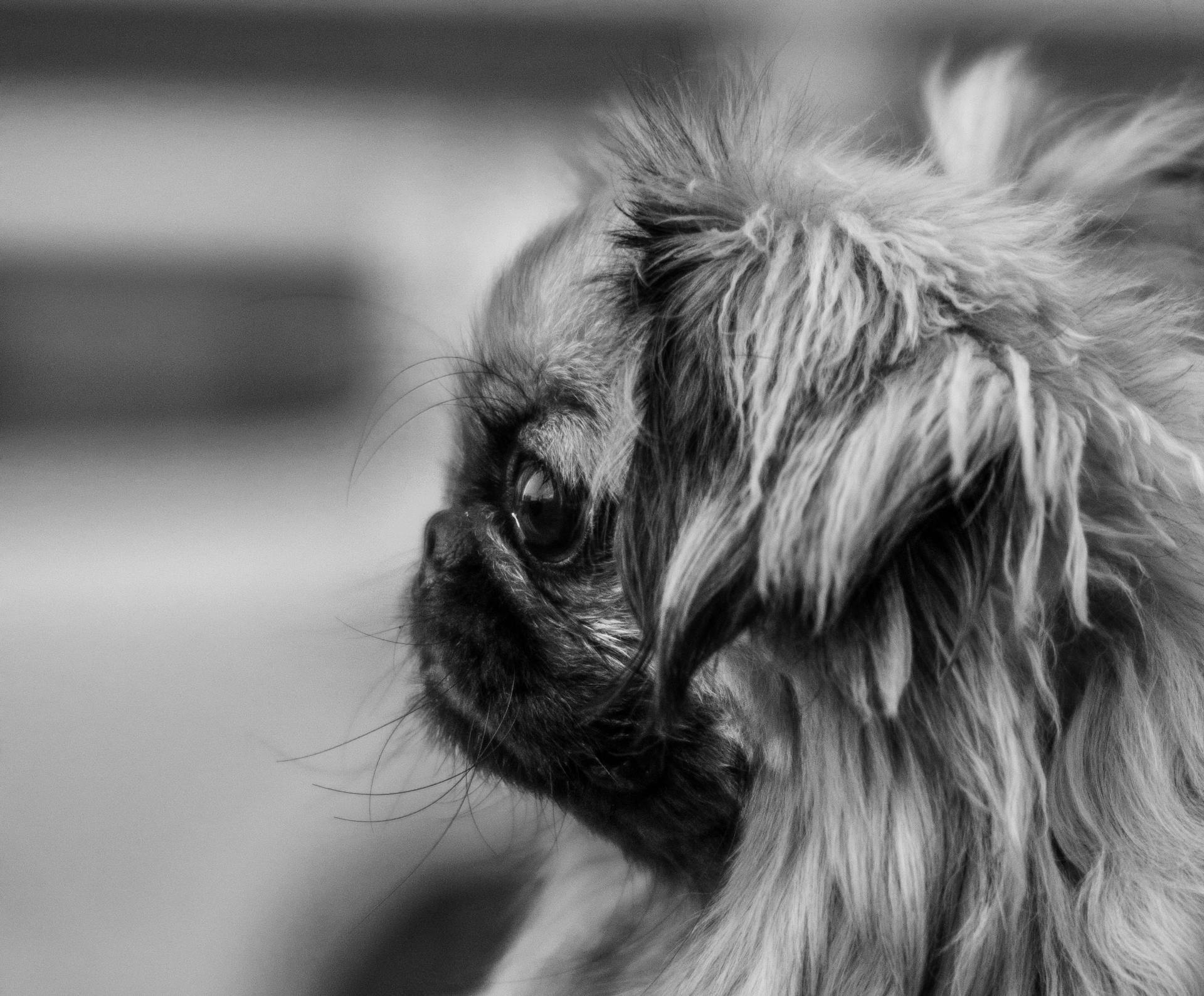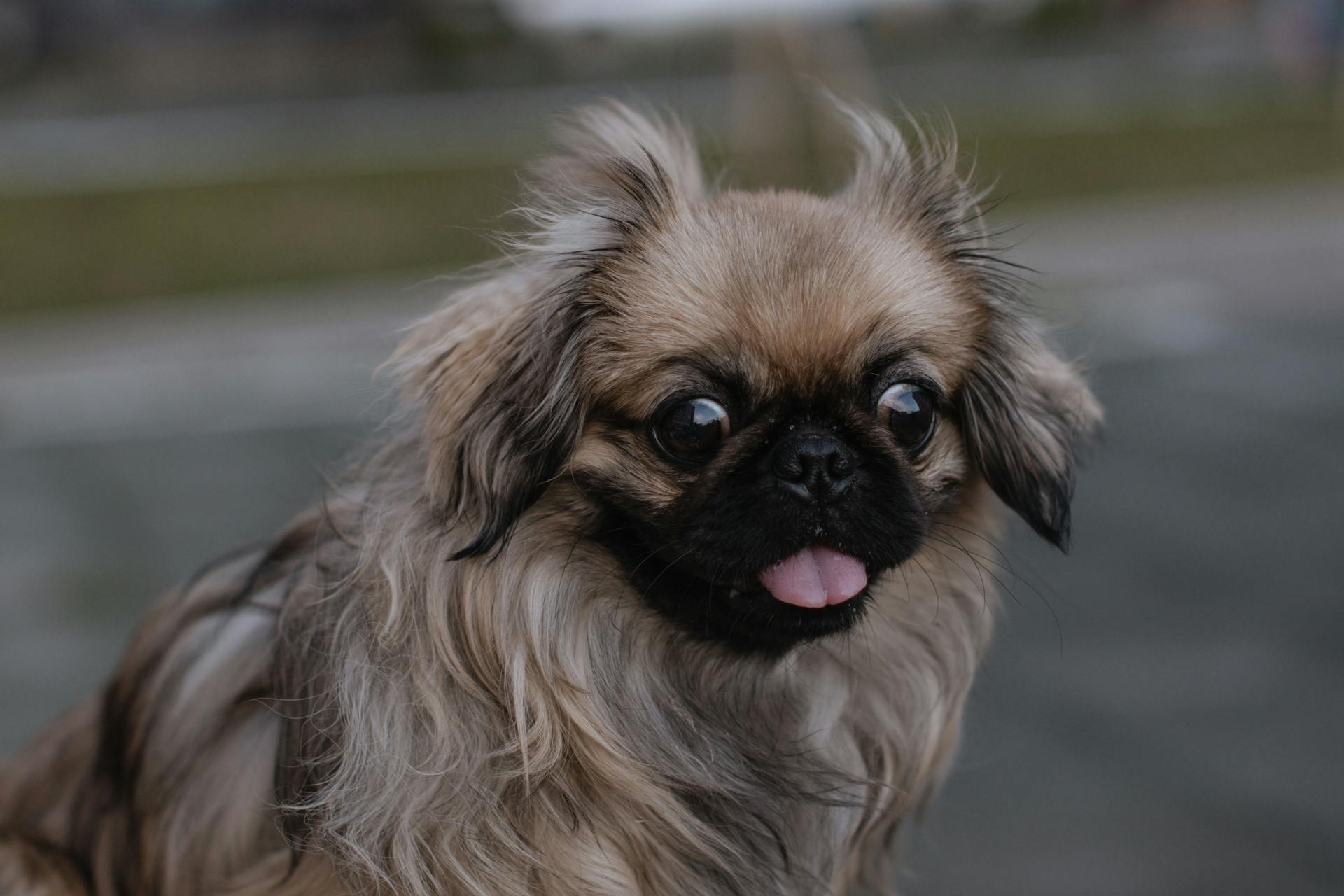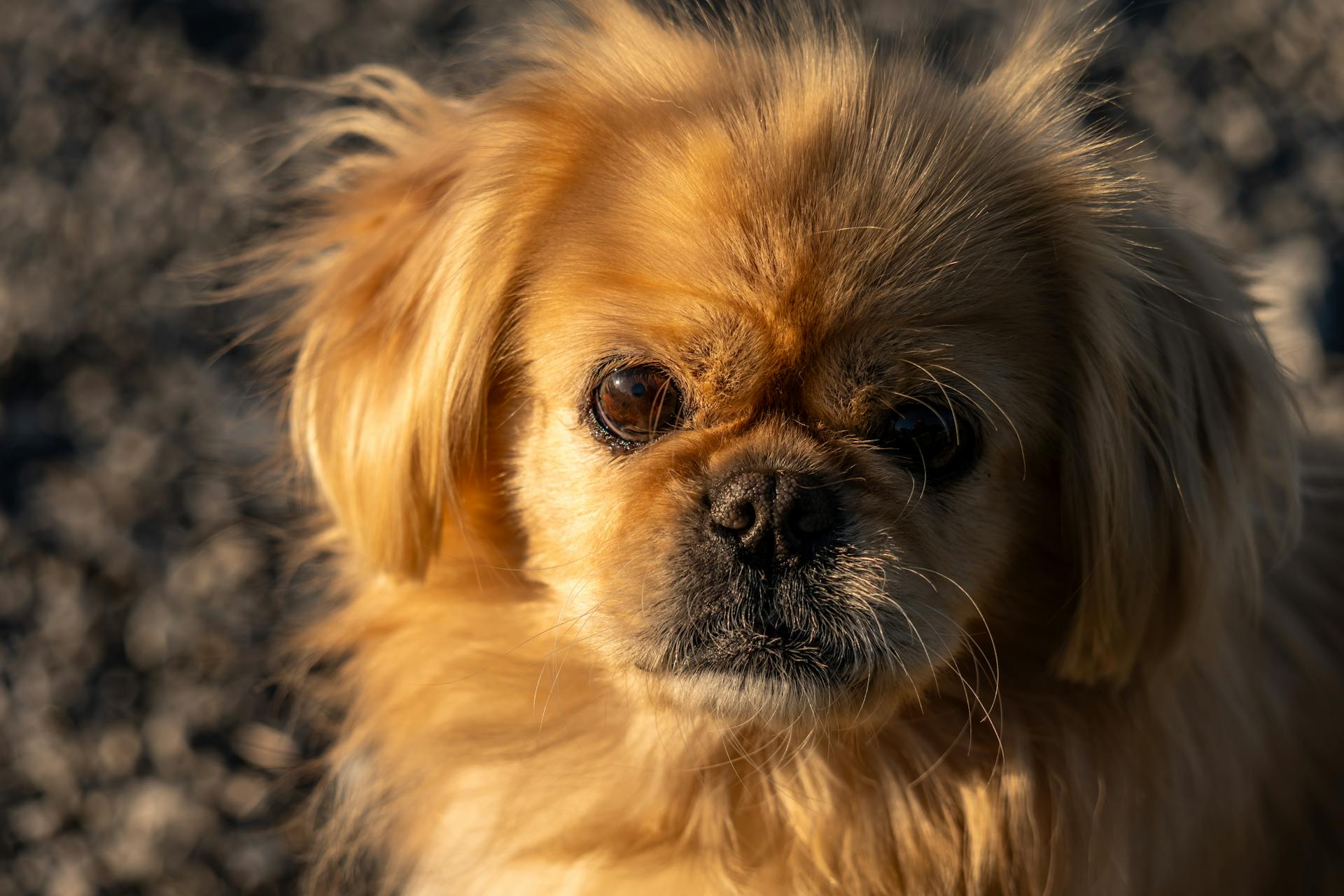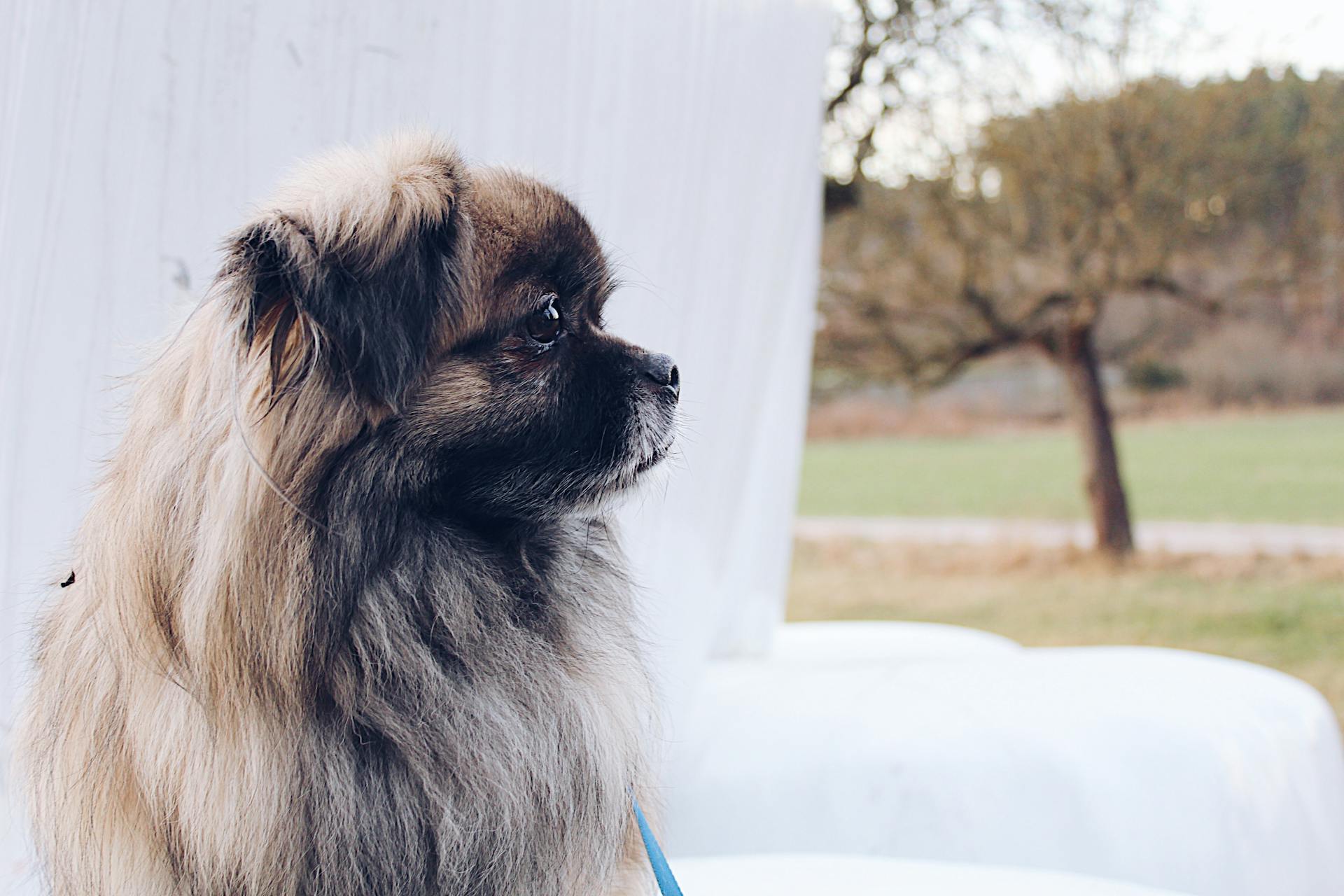
The Pekingese is a small, fluffy dog breed with a rich history dating back to ancient China. They originated as palace pets for royalty, specifically the emperors of China.
These dogs were bred to be companions, not hunters, and their small size made them perfect for palace life. They were also known for their flat faces and short snouts.
One of the most distinctive features of the Pekingese is their long, flowing coat, which requires regular grooming to prevent matting and tangling.
Take a look at this: Service Dog Vest for Small Dogs
Appearance
The Pekingese's flat face and large eyes are some of the breed's most obvious characteristics. Their compact and low-to-the-ground body is a result of selective breeding.
Their coat is a defining feature, with a long and dense mane around the neck, giving them the appearance of a lion's mane. This mane is a result of their natural long hair, which covers their entire body unless trimmed short.
Pekingese ears are heart-shaped and lie flat against the head, framing the face and accentuating its shape.
Their eyes are very large, round, and dark, with a bold but not bulging appearance. Their nose is broad and short, which gives them their characteristically smooshy faces.
A Pekingese's coat has a coarse texture on the outside and a softer undercoat. The thighs, forelegs, and toes have long feathers, adding to their overall fluffy appearance.
Here are the 11 standard colors of the Pekingese breed:
- biscuit
- black
- gray
- red
- fawn sable (color is darker at the tips)
- gray
- more
- black mask
Their tail is set high with a slight arch and should be free from kinks or curls, carried over the back and covered with profuse fringing.
Health
The Pekingese is a relatively long-lived breed, with a typical lifespan of 12-14 years. However, like many breeds, they can be prone to certain health issues.
Trauma is the leading cause of death for Pekingese, and they can also be susceptible to neurological and cardiovascular defects. This is often due to breeding practices that prioritize physical characteristics over health.
Worth a look: Pekingese Dog Health Problems
One of the most significant health concerns for Pekingese is brachycephaly, which can lead to breathing problems, eye issues, and skin allergies. This is because their flattened face and tiny skull can cause their airways to become restricted, making it difficult for them to breathe.
In an effort to address these issues, the Kennel Club significantly changed the breed standard in 2008, removing the clause that the "profile [should be] flat with nose well up between eyes" and adding instead that the "muzzle must be evident". This change aims to reduce the likelihood of breathing difficulties in the breed.
Here are some common health issues that Pekingese may experience:
- Dental disease
- Obesity
- Brachycephalic syndrome
- Dry eye syndrome
- Mitral valve disease
Pekingese are also prone to back problems, such as intervertebral disc disease (IVDD), which can cause pain, difficulty walking, and even paralysis. If you suspect your Pekingese is experiencing IVDD, it's essential to seek veterinary attention immediately.
In addition to these issues, Pekingese may also be susceptible to heart problems, such as mitral valve disease, which can cause a heart murmur. If your vet detects a heart murmur, they may refer you to a veterinary cardiologist for further testing.
It's essential to be aware of these potential health issues and take steps to prevent them, such as maintaining a healthy weight, providing regular exercise, and scheduling regular veterinary check-ups.
Pet Care Considerations
Pekingese dogs require daily brushing to keep their coat healthy and presentable.
Their thick double coat needs to be brushed frequently to prevent matting, and they need to be taken to the groomer every 8-12 weeks for a show coat, or every few months for a puppy cut.
Pekingese dogs are prone to overheating, so it's essential to keep them cool, especially in hot weather, as they can easily suffer from heatstroke.
They need access to plenty of water before, during, and after exercise to prevent overheating and dehydration.
Pekingese dogs are brachycephalic, which means they have short snouts and are at a higher risk for breathing difficulties, so exercise should be limited to 30 minutes or less per day.
If your Pekingese starts wheezing during exercise, it's crucial to stop immediately and let them rest in a cool place until their breathing returns to normal.
Regular grooming is necessary to prevent sores (hot spots) in the creases on their face and to keep their "trousers" or "skirt" clean and well-groomed.
These little dogs are used to being waited on, so they expect plenty of affection and attention from their devoted owners, but they also require early socialization and patient training to prevent excessive barking.
You might enjoy: What Nutrients Do Dogs Need in Homemade Dog Food
History
The Pekingese breed has a rich history that spans centuries. They originated in China from small dogs owned by aristocratic families.
In the 8th-century, the Chinese Imperial Family became fascinated with breeding small dogs, which led to the creation of the Pekingese breed. The Pekingese was bred to be a companion dog for Chinese nobles and was considered a status symbol.
The breed was protected by the Chinese emperors and was only allowed to be owned by the Imperial Family. This exclusivity made the Pekingese a highly sought-after breed, and they were often carried in the wide sleeves of their owners' robes, earning them the nickname "sleeve dogs."
In 1860, the British stormed the summer palace in Beijing, and five Pekingese dogs were rescued by British troops. The smallest of these dogs was given to Queen Victoria, introducing the breed to the British public.
The Pekingese breed has been around for over 2,000 years, dating back to the Shu Dynasty. They were originally created by Buddhist monks who selectively bred the Pekingese to create a miniature lion.
Additional reading: Are Australian Cattle Dogs Good Family Dogs
History and Origins

The Pekingese breed has a rich history that dates back over 2,000 years to the Shu Dynasty. They were originally bred to be companion dogs for the Chinese Imperial family.
In ancient China, the Pekingese were considered sacred symbols and were only allowed to be owned by the Imperial family. Removing them from the palace precinct was punishable by death. This exclusivity only added to their allure.
The Pekingese were bred to resemble a miniature lion, a symbol of Buddhism in China. According to legend, Buddha took a lion and shrunk it down to create the Pekingese breed.
The breed's origins are shrouded in mystery, but it's clear that they were highly valued by the Chinese nobility. They were often carried in the wide sleeves of their robes, earning them the nickname "sleeve dogs."
The Pekingese only came to the West after the British ransacked the Peking Palace in 1860. Five dogs were discovered in hiding and were removed by British troops before the Palace was burnt. These dogs were brought to Britain and gifted to Queen Victoria.
The Pekingese breed was first introduced to the US in the late 1890s and was registered with the American Kennel Club in 1906. Today, they rank 96 on the AKC's popularity list.
Check this out: Are German Shepherd Dogs Good Family Dogs
Related Breeds
The Pekingese has a rich history, and its unique characteristics have led to some interesting connections with other breeds. The Pekingese is often compared to the Pug, Shetland Sheepdog, and Manchester Terrier, which are all known for their small size and big personalities.
One of the most notable similarities between the Pekingese and the Pug is their short stature and compact build. Both breeds are considered toy dogs and are often kept as companions due to their affectionate nature. The Pekingese, however, has a longer, more flowing coat than the Pug, which requires regular grooming to prevent matting.
Another breed that shares some similarities with the Pekingese is the Shetland Sheepdog, also known as the Sheltie. Both breeds are known for their intelligence and loyalty, making them popular family pets. However, the Sheltie is a herding breed and requires regular exercise to stay happy and healthy.
In addition to these breeds, the Pekingese is also related to the Swedish Vallhund, a small herding breed from Sweden. Like the Pekingese, the Swedish Vallhund is known for its short stature and energetic personality.
Here's a list of breeds that are related to the Pekingese:
- Pug
- Shetland Sheepdog
- Manchester Terrier
- Swedish Vallhund
- Basenji
- Chihuahua
These breeds may not look like the Pekingese at first glance, but they share some common characteristics that make them interesting comparisons.
Three Little-Known Facts

History is full of surprises, and sometimes the most fascinating facts are the ones we don't know about.
The ancient Egyptians built over 130 pyramids, but the most impressive one is the Great Pyramid of Giza, which took around 20 years to complete.
The Great Wall of China is often considered one of the most impressive architectural feats in history, but did you know it was originally built to keep out nomadic tribes, not just as a symbol of power?
The Great Pyramid of Giza is aligned almost perfectly with the four cardinal directions, with an error of only about 3 minutes of arc.
The Roman Empire was known for its engineering skills, but they also made significant contributions to medicine, with the discovery of the circulatory system by a Roman physician named Galen.
The Great Wall of China stretches for over 4,000 miles, making it one of the longest structures ever built, but it's also surprisingly narrow in some places, with some sections only 10 feet wide.
Did You Know?

The Pekingese breed has a rich history that's full of fascinating facts. They really found fame with the character Tricky-Woo in James Herriot's veterinary books and the subsequent TV series 'All Creatures Great and Small'.
In the books, Tricky-Woo suffers from 'cracker dog' and 'flop-bott' (likely excessive energy and 'zoomies' and anal glad issues respectively). I think it's hilarious that the Pekingese in the recent remake of the series, named Derek, would upstage the actors by adding his own ad-lib 'grrs' and 'woofs' when addressed during a scene!
In ancient China, the smallest and fiercest Pekingese were kept up the wide sleeves of Emperors and couriers who would release them to fend off any potential attackers.
Behavior and Training
Pekingese are alert dogs and have a strong bark for their small size, so they might bark at novel exposures, but exposing them to new people, animals, and experiences from an early age can help reduce this tendency.
They are intelligent dogs that can be trainable, but they might not see the point in following commands, so training games and positive reinforcement are effective with this strong-willed breed.
Pekingese can be challenging to train due to their independent nature, but starting training when they're still puppies and keeping sessions short can be effective, and using plenty of positive reinforcement like treats, praise, and pets will keep them interested.
They need consistent training and guidance, and starting early helps them understand that you're the boss, so use positive reinforcement and reward-based training when they do a good job.
Socialization is also crucial for Pekingese, so take them to puppy preschool to help them interact with other dogs and people, and be sure to take them out frequently to potty train them.
Crate training is a great way to help with potty training, and finding a crate that's just the right size is essential, not too small and not too large, so they can turn around in it.
Pekingese respond well to kind dog training methods using food or toys as rewards, but they're not overly inclined to enjoy training for its own sake, so you'll need to work hard to motivate them to do as you ask.
Explore further: All about Dogs Dog Training
Behavior
Pekingese are alert dogs and have a strong bark for such a small pup, which they might use when they think something is a threat.
They can be quite protective of their territory, keeping a close eye on their surroundings and barking to let you know if anyone is approaching their kingdom.
Exposing a Pekingese to lots of new people, animals, and experiences from an early age can help reduce their tendency to bark at novel exposures.
Pekingese are generally confident and opinionated, but a happy Pekingese is pretty laid-back at home.
They're capable of learning, but you will need to work hard to motivate a Peke to do as you ask.
Pekingese bond very strongly with their families, but they're less impressed with strangers.
They can live in a house with kids and babies, but they won't necessarily want to play with them - they'd rather chill with you on the couch.
Pekingese are incredibly charming and have a huge amount of boldness and self-esteem, traits that stem from centuries of being revered by royalty.
They can sometimes bond with one member of the family more than everyone else, and while they will be affectionate with all their family, their true devotion will be reserved for their chosen person.
Pekingese puppies are playful, curious, and affectionate, but they can also be stubborn, especially when there's an area or object that they want to learn more about.
They need plenty of supervision and puppy-proofing to help keep them out of trouble, and they'll also need socialization with other pets, people, and places to help them feel more comfortable around those things in the future.
The sooner you can start training your Pekingese puppy, the better, as they need consistent training and guidance.
One potential area of difficulty is potty training - small dogs like Pekingese have small bladders and need to go out more frequently, and their cues aren't as obvious as those of larger breeds.
Crate training is a great way to help potty train your puppy, as dogs like to keep their "dens" clean.
Recommended read: Indoor Dog Potty for Male Dogs
Exercise
The Pekingese is not a high-energy breed, which makes them perfect for people with busy schedules or health issues. They require short leisurely walks and indoor playtime to stay happy and healthy.
One of the best things about Pekingese is that they can thrive with minimal exercise, making them a great choice for older people or those who work frequently. They're happy to spend their days lounging around the house.
To keep your Pekingese happy and healthy, aim for a short walk of 20 to 30 minutes every day. Some may enjoy joining in dog sports like agility, but don't expect them to win any prizes for speed.
Pekingese don't cope well with hot weather due to their short muzzles, so it's best to keep them inside on hot days or take your walks in the cooler parts of the day.
Here's an interesting read: Best Dog Food for Gassy Dogs
Frequently Asked Questions
Are Pekingese good family dogs?
Yes, Pekingese are well-suited for loving families with gentle children, as they bond closely with their owners and thrive in a calm, affectionate environment. They make wonderful companions for families who can provide the right care and attention.
Do Pekingese bark a lot?
Pekingese are known to be vigilant watchdogs and may bark to alert their family to suspicious activity. Early socialization can help reduce excessive barking in unfamiliar situations.
Is Pekingese a Shih Tzu?
No, the Pekingese is not a Shih Tzu, but rather one of the breeds believed to have contributed to the Shih Tzu's origins. The Shih Tzu is a distinct breed that originated from Tibet, with a unique history and characteristics.
Why are Pekingese so rare?
Pekingese are not extremely rare, but their declining popularity makes them less commonly seen than other toy breeds. Their perceived rarity is mainly due to their decreasing popularity, not a true scarcity of the breed.
Do Pekingese dogs like to cuddle?
Pekingese dogs are known to adore affection and will often demand cuddles from their owners. They thrive on attention and physical touch, making them a great fit for families who love to snuggle.
Featured Images: pexels.com


